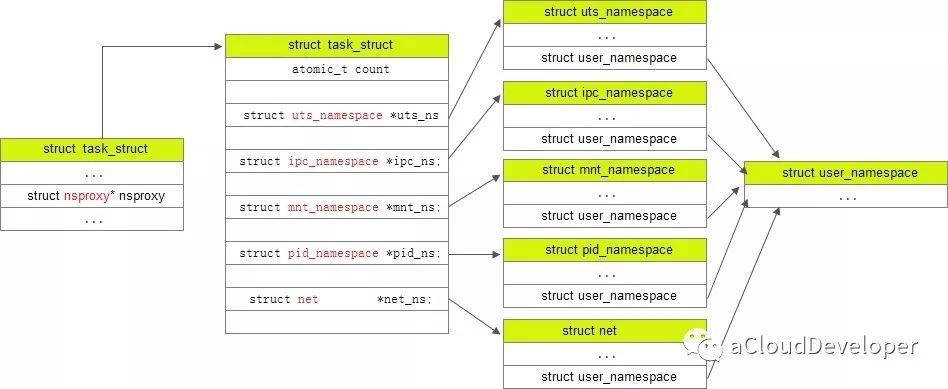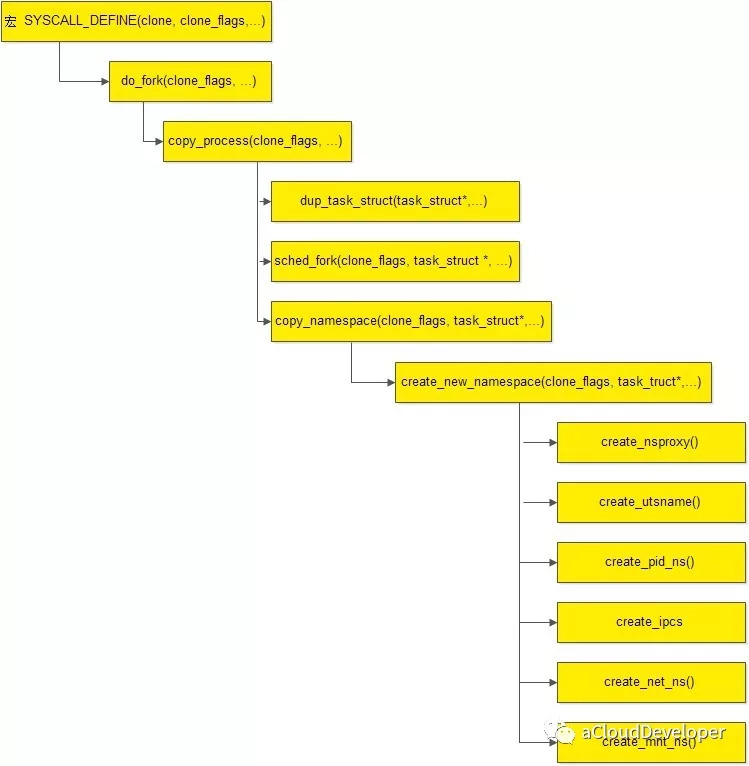文章首发于我的公众号「Linux云计算网络」,欢迎关注,第一时间掌握技术干货!
上篇我们从进程 clone 的角度,结合代码简单分析了 Linux 提供的 6 种 namespace,本篇从源码上进一步分析 Linux namespace,让你对 Docker namespace 的隔离机制有更深的认识。我用的是 Linux-4.1.19 的版本,由于 namespace 模块更新都比较少,所以,只要 3.0 以上的版本都是差不多的。
从内核进程描述符 task_struct 开始切入
由于 Linux namespace 是用来做进程资源隔离的,所以在进程描述符中,一定有 namespace 所对应的信息,我们可以从这里开始切入代码。
首先找到描述进程信息 task_struct,找到指向 namespace 的结构 struct *nsproxy(sched.h):1
2
3
4
5
6struct task_struct {
......
/* namespaces */
struct nsproxy *nsproxy;
......
}
其中 nsproxy 结构体定义在 nsproxy.h 中:1
2
3
4
5
6
7
8
9
10
11
12
13
14
15
16
17
18
19
20
21/*
* A structure to contain pointers to all per-process
* namespaces - fs (mount), uts, network, sysvipc, etc.
*
* 'count' is the number of tasks holding a reference.
* The count for each namespace, then, will be the number
* of nsproxies pointing to it, not the number of tasks.
*
* The nsproxy is shared by tasks which share all namespaces.
* As soon as a single namespace is cloned or unshared, the
* nsproxy is copied.
*/
struct nsproxy {
atomic_t count;
struct uts_namespace *uts_ns;
struct ipc_namespace *ipc_ns;
struct mnt_namespace *mnt_ns;
struct pid_namespace *pid_ns;
struct net *net_ns;
};
extern struct nsproxy init_nsproxy;
这个结构是被所有 namespace 所共享的,只要一个 namespace 被 clone 了,nsproxy 也会被 clone。注意到,由于 user namespace 是和其他 namespace 耦合在一起的,所以没出现在上述结构中。
同时,nsproxy.h 中还定义了一些对 namespace 的操作,包括 copy_namespaces 等。1
2
3
4
5
6int copy_namespaces(unsigned long flags, struct task_struct *tsk);
void exit_task_namespaces(struct task_struct *tsk);
void switch_task_namespaces(struct task_struct *tsk, struct nsproxy *new);
void free_nsproxy(struct nsproxy *ns);
int unshare_nsproxy_namespaces(unsigned long, struct nsproxy **,
struct fs_struct *);
task_struct,nsproxy,几种 namespace 之间的关系如下所示:

各个 namespace 的初始化
在各个 namespace 结构定义下都有个 init 函数,nsproxy 也有个 init_nsproxy 函数,init_nsproxy 在 task 初始化的时候会被初始化,附带的,init_nsproxy 中定义了各个 namespace 的 init 函数,如下:
在 init_task 函数中(init_task.h):1
2
3
4
5
6
7
8
9
10/*
* INIT_TASK is used to set up the first task table, touch at
* your own risk!. Base=0, limit=0x1fffff (=2MB)
*/
#define INIT_TASK(tsk) \
{
......
.nsproxy = &init_nsproxy,
......
}
继续跟进 init_nsproxy,在 nsproxy.c 中:1
2
3
4
5
6
7
8
9
10
11
12struct nsproxy init_nsproxy = {
.count = ATOMIC_INIT(1),
.uts_ns = &init_uts_ns,
#if defined(CONFIG_POSIX_MQUEUE) || defined(CONFIG_SYSVIPC)
.ipc_ns = &init_ipc_ns,
#endif
.mnt_ns = NULL,
.pid_ns_for_children = &init_pid_ns,
#ifdef CONFIG_NET
.net_ns = &init_net,
#endif
};
可见,init_nsproxy 中,对 uts, ipc, pid, net 都进行了初始化,但 mount 却没有。
创建新的 namespace
初始化完之后,下面看看如何创建一个新的 namespace,通过前面的文章,我们知道是通过 clone 函数来完成的,在 Linux kernel 中,fork/vfork() 对 clone 进行了封装,如下:1
2
3
4
5
6
7
8
9
10
11
12
13
14
15
16
17
18
19
20
21
22
23
24
25
26
27
28
29
30
31
32
33
34
35
36
37
38
39
40
41
42
43
44
45
46#ifdef __ARCH_WANT_SYS_FORK
SYSCALL_DEFINE0(fork)
{
#ifdef CONFIG_MMU
return do_fork(SIGCHLD, 0, 0, NULL, NULL);
#else
/* can not support in nommu mode */
return -EINVAL;
#endif
}
#endif
#ifdef __ARCH_WANT_SYS_VFORK
SYSCALL_DEFINE0(vfork)
{
return do_fork(CLONE_VFORK | CLONE_VM | SIGCHLD, 0, 0, NULL, NULL);
}
#endif
#ifdef __ARCH_WANT_SYS_CLONE
#ifdef CONFIG_CLONE_BACKWARDS
SYSCALL_DEFINE5(clone, unsigned long, clone_flags, unsigned long, newsp,
int __user *, parent_tidptr,
int, tls_val,
int __user *, child_tidptr)
#elif defined(CONFIG_CLONE_BACKWARDS2)
SYSCALL_DEFINE5(clone, unsigned long, newsp, unsigned long, clone_flags,
int __user *, parent_tidptr,
int __user *, child_tidptr,
int, tls_val)
#elif defined(CONFIG_CLONE_BACKWARDS3)
SYSCALL_DEFINE6(clone, unsigned long, clone_flags, unsigned long, newsp,
int, stack_size,
int __user *, parent_tidptr,
int __user *, child_tidptr,
int, tls_val)
#else
SYSCALL_DEFINE5(clone, unsigned long, clone_flags, unsigned long, newsp,
int __user *, parent_tidptr,
int __user *, child_tidptr,
int, tls_val)
#endif
{
return do_fork(clone_flags, newsp, 0, parent_tidptr, child_tidptr);
}
#endif
可以看到,无论是 fork() 还是 vfork(),最终都会调用到 do_fork() 函数:
1 | /* |
do_fork() 首先调用 copy_process 将父进程信息复制给子进程,然后调用 vfork() 完成相关的初始化工作,接着调用 wake_up_new_task() 将进程加入调度器中,为之分配 CPU。最后,等待子进程退出。
copy_process():1
2
3
4
5
6
7
8
9
10
11
12
13
14
15
16
17
18
19
20
21
22
23
24
25
26
27
28
29
30
31
32
33
34
35
36
37
38
39
40
41
42
43
44
45
46
47
48
49
50
51
52
53
54
55
56
57
58
59
60
61
62
63
64
65
66
67
68
69
70
71
72
73
74
75
76
77
78
79
80
81
82
83
84
85
86
87
88
89
90
91
92
93
94
95
96
97
98
99
100
101
102
103
104
105
106
107
108
109
110
111
112
113
114
115
116
117
118
119
120
121
122
123
124
125
126
127
128
129
130
131
132
133
134
135
136
137
138
139
140
141
142
143
144
145
146
147
148
149
150
151
152
153
154
155
156
157
158
159
160
161
162
163
164
165
166
167
168
169static struct task_struct *copy_process(unsigned long clone_flags,
unsigned long stack_start,
unsigned long stack_size,
int __user *child_tidptr,
struct pid *pid,
int trace)
{
int retval;
// 创建进程描述符指针
struct task_struct *p;
// 检查 clone flags 的合法性,比如 CLONE_NEWNS 与 CLONE_FS 是互斥的
if ((clone_flags & (CLONE_NEWNS|CLONE_FS)) == (CLONE_NEWNS|CLONE_FS))
return ERR_PTR(-EINVAL);
if ((clone_flags & (CLONE_NEWUSER|CLONE_FS)) == (CLONE_NEWUSER|CLONE_FS))
return ERR_PTR(-EINVAL);
/*
* Thread groups must share signals as well, and detached threads
* can only be started up within the thread group.
*/
if ((clone_flags & CLONE_THREAD) && !(clone_flags & CLONE_SIGHAND))
return ERR_PTR(-EINVAL);
/*
* Shared signal handlers imply shared VM. By way of the above,
* thread groups also imply shared VM. Blocking this case allows
* for various simplifications in other code.
*/
if ((clone_flags & CLONE_SIGHAND) && !(clone_flags & CLONE_VM))
return ERR_PTR(-EINVAL);
/*
* Siblings of global init remain as zombies on exit since they are
* not reaped by their parent (swapper). To solve this and to avoid
* multi-rooted process trees, prevent global and container-inits
* from creating siblings.
*/
// 比如CLONE_PARENT时得检查当前signal flags是否为SIGNAL_UNKILLABLE,防止kill init进程。
if ((clone_flags & CLONE_PARENT) &&
current->signal->flags & SIGNAL_UNKILLABLE)
return ERR_PTR(-EINVAL);
/*
* If the new process will be in a different pid or user namespace
* do not allow it to share a thread group or signal handlers or
* parent with the forking task.
*/
if (clone_flags & CLONE_SIGHAND) {
if ((clone_flags & (CLONE_NEWUSER | CLONE_NEWPID)) ||
(task_active_pid_ns(current) !=
current->nsproxy->pid_ns_for_children))
return ERR_PTR(-EINVAL);
}
retval = security_task_create(clone_flags);
if (retval)
goto fork_out;
retval = -ENOMEM;
// 复制当前的 task_struct
p = dup_task_struct(current);
if (!p)
goto fork_out;
ftrace_graph_init_task(p);
rt_mutex_init_task(p);
#ifdef CONFIG_PROVE_LOCKING
DEBUG_LOCKS_WARN_ON(!p->hardirqs_enabled);
DEBUG_LOCKS_WARN_ON(!p->softirqs_enabled);
#endif
retval = -EAGAIN;
// 检查进程是否超过限制,由 OS 定义
if (atomic_read(&p->real_cred->user->processes) >=
task_rlimit(p, RLIMIT_NPROC)) {
if (p->real_cred->user != INIT_USER &&
!capable(CAP_SYS_RESOURCE) && !capable(CAP_SYS_ADMIN))
goto bad_fork_free;
}
current->flags &= ~PF_NPROC_EXCEEDED;
retval = copy_creds(p, clone_flags);
if (retval < 0)
goto bad_fork_free;
/*
* If multiple threads are within copy_process(), then this check
* triggers too late. This doesn't hurt, the check is only there
* to stop root fork bombs.
*/
retval = -EAGAIN;
// 检查进程数是否超过 max_threads,由内存大小定义
if (nr_threads >= max_threads)
goto bad_fork_cleanup_count;
// ......
// 初始化 io 计数器
task_io_accounting_init(&p->ioac);
acct_clear_integrals(p);
// 初始化 CPU 定时器
posix_cpu_timers_init(p);
// ......
// 初始化进程数据结构,并为进程分配 CPU,进程状态设置为 TASK_RUNNING
/* Perform scheduler related setup. Assign this task to a CPU. */
retval = sched_fork(clone_flags, p);
if (retval)
goto bad_fork_cleanup_policy;
retval = perf_event_init_task(p);
if (retval)
goto bad_fork_cleanup_policy;
retval = audit_alloc(p);
if (retval)
goto bad_fork_cleanup_perf;
/* copy all the process information */
// 复制所有进程信息,包括文件系统,信号处理函数、信号、内存管理等
shm_init_task(p);
retval = copy_semundo(clone_flags, p);
if (retval)
goto bad_fork_cleanup_audit;
retval = copy_files(clone_flags, p);
if (retval)
goto bad_fork_cleanup_semundo;
retval = copy_fs(clone_flags, p);
if (retval)
goto bad_fork_cleanup_files;
retval = copy_sighand(clone_flags, p);
if (retval)
goto bad_fork_cleanup_fs;
retval = copy_signal(clone_flags, p);
if (retval)
goto bad_fork_cleanup_sighand;
retval = copy_mm(clone_flags, p);
if (retval)
goto bad_fork_cleanup_signal;
// !!! 复制 namespace
retval = copy_namespaces(clone_flags, p);
if (retval)
goto bad_fork_cleanup_mm;
retval = copy_io(clone_flags, p);
if (retval)
goto bad_fork_cleanup_namespaces;
// 初始化子进程内核栈
retval = copy_thread(clone_flags, stack_start, stack_size, p);
if (retval)
goto bad_fork_cleanup_io;
// 为新进程分配新的 pid
if (pid != &init_struct_pid) {
pid = alloc_pid(p->nsproxy->pid_ns_for_children);
if (IS_ERR(pid)) {
retval = PTR_ERR(pid);
goto bad_fork_cleanup_io;
}
}
// ......
// 返回新进程 p
return p;
}
copy_process 主要分为三步:首先调用 dup_task_struct() 复制当前的进程描述符信息 task_struct,为新进程分配新的堆栈,第二步调用 sched_fork() 初始化进程数据结构,为其分配 CPU,把进程状态设置为 TASK_RUNNING,最后一步就是调用 copy_namespaces() 复制 namesapces。我们重点关注最后一步 copy_namespaces():1
2
3
4
5
6
7
8
9
10
11
12
13
14
15
16
17
18
19
20
21
22
23
24
25
26
27
28
29
30
31
32
33
34
35
36
37/*
* called from clone. This now handles copy for nsproxy and all
* namespaces therein.
*/
int copy_namespaces(unsigned long flags, struct task_struct *tsk)
{
struct nsproxy *old_ns = tsk->nsproxy;
struct user_namespace *user_ns = task_cred_xxx(tsk, user_ns);
struct nsproxy *new_ns;
if (likely(!(flags & (CLONE_NEWNS | CLONE_NEWUTS | CLONE_NEWIPC |
CLONE_NEWPID | CLONE_NEWNET)))) {
get_nsproxy(old_ns);
return 0;
}
if (!ns_capable(user_ns, CAP_SYS_ADMIN))
return -EPERM;
/*
* CLONE_NEWIPC must detach from the undolist: after switching
* to a new ipc namespace, the semaphore arrays from the old
* namespace are unreachable. In clone parlance, CLONE_SYSVSEM
* means share undolist with parent, so we must forbid using
* it along with CLONE_NEWIPC.
*/
if ((flags & (CLONE_NEWIPC | CLONE_SYSVSEM)) ==
(CLONE_NEWIPC | CLONE_SYSVSEM))
return -EINVAL;
new_ns = create_new_namespaces(flags, tsk, user_ns, tsk->fs);
if (IS_ERR(new_ns))
return PTR_ERR(new_ns);
tsk->nsproxy = new_ns;
return 0;
}
可见,copy_namespace() 主要基于“旧的” namespace 创建“新的” namespace,核心函数在于 create_new_namespaces:1
2
3
4
5
6
7
8
9
10
11
12
13
14
15
16
17
18
19
20
21
22
23
24
25
26
27
28
29
30
31
32
33
34
35
36
37
38
39
40
41
42
43
44
45
46
47
48
49
50
51
52
53
54
55
56
57
58
59
60
61
62
63
64
65
66
67/*
* Create new nsproxy and all of its the associated namespaces.
* Return the newly created nsproxy. Do not attach this to the task,
* leave it to the caller to do proper locking and attach it to task.
*/
static struct nsproxy *create_new_namespaces(unsigned long flags,
struct task_struct *tsk, struct user_namespace *user_ns,
struct fs_struct *new_fs)
{
struct nsproxy *new_nsp;
int err;
// 创建新的 nsproxy
new_nsp = create_nsproxy();
if (!new_nsp)
return ERR_PTR(-ENOMEM);
//创建 mnt namespace
new_nsp->mnt_ns = copy_mnt_ns(flags, tsk->nsproxy->mnt_ns, user_ns, new_fs);
if (IS_ERR(new_nsp->mnt_ns)) {
err = PTR_ERR(new_nsp->mnt_ns);
goto out_ns;
}
//创建 uts namespace
new_nsp->uts_ns = copy_utsname(flags, user_ns, tsk->nsproxy->uts_ns);
if (IS_ERR(new_nsp->uts_ns)) {
err = PTR_ERR(new_nsp->uts_ns);
goto out_uts;
}
//创建 ipc namespace
new_nsp->ipc_ns = copy_ipcs(flags, user_ns, tsk->nsproxy->ipc_ns);
if (IS_ERR(new_nsp->ipc_ns)) {
err = PTR_ERR(new_nsp->ipc_ns);
goto out_ipc;
}
//创建 pid namespace
new_nsp->pid_ns_for_children =
copy_pid_ns(flags, user_ns, tsk->nsproxy->pid_ns_for_children);
if (IS_ERR(new_nsp->pid_ns_for_children)) {
err = PTR_ERR(new_nsp->pid_ns_for_children);
goto out_pid;
}
//创建 network namespace
new_nsp->net_ns = copy_net_ns(flags, user_ns, tsk->nsproxy->net_ns);
if (IS_ERR(new_nsp->net_ns)) {
err = PTR_ERR(new_nsp->net_ns);
goto out_net;
}
return new_nsp;
// 出错处理
out_net:
if (new_nsp->pid_ns_for_children)
put_pid_ns(new_nsp->pid_ns_for_children);
out_pid:
if (new_nsp->ipc_ns)
put_ipc_ns(new_nsp->ipc_ns);
out_ipc:
if (new_nsp->uts_ns)
put_uts_ns(new_nsp->uts_ns);
out_uts:
if (new_nsp->mnt_ns)
put_mnt_ns(new_nsp->mnt_ns);
out_ns:
kmem_cache_free(nsproxy_cachep, new_nsp);
return ERR_PTR(err);
}
在create_new_namespaces()中,分别调用 create_nsproxy(), create_utsname(), create_ipcs(), create_pid_ns(), create_net_ns(), create_mnt_ns() 来创建 nsproxy 结构,uts,ipcs,pid,mnt,net。
具体的函数我们就不再分析,基本到此为止,我们从子进程创建,到子进程相关的信息的初始化,包括文件系统,CPU,内存管理等,再到各个 namespace 的创建,都走了一遍,下面附上 namespace 创建的代码流程图。

mnt namespace:
1 | mnt namespace: |
可以看到,mount namespace 在新建时会新建一个新的 namespace,然后将父进程的 namespace 拷贝过来,并将 mount->mnt_ns 指向新的 namespace。接着设置进程的 root 路径以及当前路径到新的 namespace,然后为新进程设置新的 vfs 等。从这里就可以看出,在子进程中进行 mount 操作不会影响到父进程中的 mount 信息。
uts namespace:
1 | static inline struct uts_namespace *copy_utsname(unsigned long flags, |
uts namespace 直接返回父进程 namespace 信息。
ipc namespace:
1 | struct ipc_namespace *copy_ipcs(unsigned long flags, |
ipc namespace 如果是设置了参数 CLONE_NEWIPC,则直接返回父进程的 namespace,否则返回新创建的 namespace。
pid namespace:
1 | static inline struct pid_namespace *copy_pid_ns(unsigned long flags, |
pid namespace 直接返回父进程的 namespace。
net namespace
1 | static inline struct net *copy_net_ns(unsigned long flags, |
net namespace 也是直接返回父进程的 namespace。
OK,不知不觉写了这么多,但回头去看,这更像是代码走读,分析深度不够,更详细的大家可以参照源码,源码结构还是比较清晰的。
PS:文章未经我允许,不得转载,否则后果自负。
欢迎扫👇的二维码关注我的微信公众号,后台回复「m」,可以获取往期所有技术博文推送,更多资料回复下列关键字获取。
